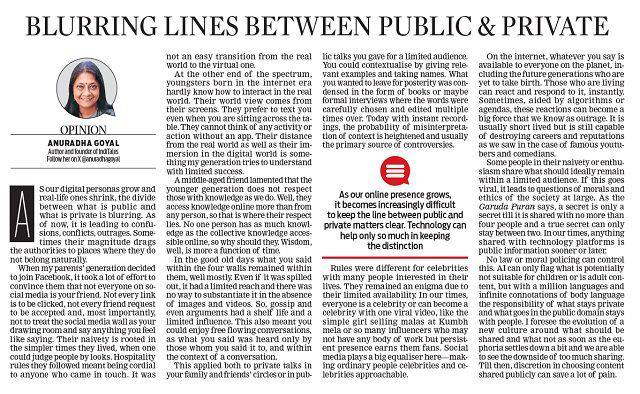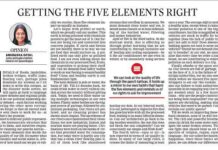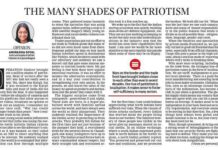As our digital personas grow and real-life ones shrink, the divide between what is public and what is private is blurring. As of now, it is leading to confusions, conflicts, outrages. Sometimes their magnitude drags the authorities to places where they do not belong naturally.
 When my parents’ generation decided to join Facebook, it took a lot of effort to convince them that not everyone on social media is your friend. Not every link is to be clicked, not every friend request to be accepted and, most importantly, not to treat the social media wall as your drawing room and say anything you feel like saying. Their naivety is rooted in the simpler times they lived, when one could judge people by looks. Hospitality rules they followed meant being cordial to anyone who came in touch. It was not an easy transition from the real world to the virtual one. We need to keep a hawk-eye on them with UPI apps installed on their phones.
When my parents’ generation decided to join Facebook, it took a lot of effort to convince them that not everyone on social media is your friend. Not every link is to be clicked, not every friend request to be accepted and, most importantly, not to treat the social media wall as your drawing room and say anything you feel like saying. Their naivety is rooted in the simpler times they lived, when one could judge people by looks. Hospitality rules they followed meant being cordial to anyone who came in touch. It was not an easy transition from the real world to the virtual one. We need to keep a hawk-eye on them with UPI apps installed on their phones.
At the other end of the spectrum, youngsters born in the internet era hardly know how to interact in the real world. Their world view comes from their screens. They prefer to text you even when you are sitting across the table. They cannot think of any activity or action without an app. Their distance from the real world as well as their immersion in the digital world is something my generation tries to understand with limited success. We are that generation that has seen the world before the internet and social media and now navigate a world where you would struggle to prove your identity in the absence of your mobile phone. We still enjoy conversations without technology but of course cannot live without it.
In the good old days what you said within the four walls remained within them, well mostly. Even if it was spilled out, it had a limited reach and there was no way to substantiate it in the absence of images and videos. So, gossip and even arguments had a shelf life and a limited influence. This also meant you could enjoy free flowing conversations, as what you said was heard only by those whom you said it to, and within the context of a conversation.
This applied both to private talks in your family and friends’ circles or in public talks you gave for a limited audience. You could contextualise by giving relevant examples and taking names. What you wanted to leave for posterity was condensed in the form of books or maybe formal interviews where the words were carefully chosen and edited multiple times over. Today with instant recordings, the probability of misinterpretation of context is heightened and usually the primary source of controversies.
Rules were different for celebrities with many people interested in their lives. They remained an enigma due to their limited availability. In our times, everyone is a celebrity or can become a celebrity with one viral video, like the simple girl selling malas at Kumbh mela or so many influencers who may not have any body of work but persistent presence earns them fans. Social media plays a big equaliser here—making ordinary people celebrities and celebrities approachable.
On the internet, whatever you say is available to everyone on the planet, including the future generations who are yet to take birth. Those who are living can react and respond to it, instantly. Sometimes, aided by algorithms or agendas, these reactions can become a big force that we know as outrage. It is usually short lived but is still capable of destroying careers and reputations as we saw in the case of famous youtubers and comedians.
Our digital personalities are still a slice of our lives, but what we share in the spur of a moment might spill from our private selves to the public. Most of us choose to present a part of our persona online, that is why we see the happiest self of most people online. Digital creators carefully choose to build and present their personal branding that would maximise their reach to their intended audience.
Who controls the sharing of content from private events at homes, offices, colleges, cafes, or casual chit-chat between friends? No one, really. Some people either in their naivety or enthusiasm, share what should ideally remain within a limited audience. If this goes viral, it leads to questions of morals and ethics of the society at large. As the Garuda Puran says, a secret is only a secret till it is shared with no more than four people and a true secret can only stay between two. In our times, anything shared with technology platforms is public information, sooner or later.
No law or moral policing can ever control this. AI can only flag what is potentially not suitable for children or is adult content, but with a million languages and infinite connotations of body language the responsibility of what stays private and what goes in the public domain stays with people. I foresee the evolution of a new culture around what should be shared and what not as soon as the euphoria settles down a bit and we are able to see the downside of too much sharing. Till then, a careful discretion of choosing content shared publicly can save a lot of pain and embarrassment.A demarcation between public and private must be drawn.
First Published in The Indian Express on Oct 12, 2025.








